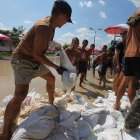
Nano-sacks could replace traditional sandbags for flood control
Flickr/#PACOM
[BANGKOK] Recent flooding in Thailand has given the country's nanotechnology research centre an opportunity to show how nano products ranging from antimaterial bednets to flood prevention technology could help mitigate the impact of future natural disasters.
One example is the nano-sack or N-Sack, a product that resembles giant, superabsorbent diapers (nappies). It uses hydrogel and nano coating to absorb water, and is being promoted as a potential replacement for traditional sandbags for flood control.
"It is our hope that the nano-sack development will be refined and can be used before the next rainy season," Sirirurg Songsivilai, executive director of the state-run National Nanotechnology Center told SciDev.Net.
"The 2011 flood in Thailand was an eye opener for both the public and the government sector. It provided our research institution with an opportunity to participate in relief efforts," he said.
For example, Sirirurg said that the research centre distributed bednets, mosquito-repellent gel and powder, all making use of nanotechnology. The net material contains a nano-scale formulation of the chemical deltamethrin, which is absorbed by receptor cells at the tips of the legs of mosquitoes and kills them within minutes.
In association with the Petroleum Authority of Thailand, the research centre has also manufactured nanotechnology-based surface-cleaning solutions for homes and offices, which have been distributed to flood victims.
Sirirurg described these as more environment-friendly than conventional cleaning solutions as they consist of biodegradable materials, are locally sourced and are inexpensive. They also reinforce the government's efforts to promote nanotechnology as an internationally competitive industry.
The centre has also showcased a test kit for leptospirosis, a disease spread through contaminated water.
For the past decade, the Thai government has been investing in nanotechnology research and development, which seeks to create novel products that operate at the molecular level. Its goal is to make Thailand a major hub of nanotechnology research in Asia.
These efforts rose to prominence after Thailand's economy suffered from the 1997 Asian financial crisis, prompting the government to identify and promote industries that would make the country more globally competitive. Nanotechnology was identified as one of these industries, which led to the creation of the Bangkok-based centre in 2003.
Since its establishment, the nanotechnology centre has been developing a range of nano-products, particularly those that might support the agriculture sector. This is seen as a strategic move, as Thailand is one of the world's biggest exporters of rice, sugar and rubber.
After the 2011 flooding, the centre has designated disaster prevention and management as a priority
Sirirurg has acknowledged the importance of using nanotechnology to help flood victims and limit the spread of flood-borne diseases such as malaria. He hopes that the nanotechnology centre can also develop products, such as the N-Sacks, that can prevent this type of flooding from recurring.



No comments:
Post a Comment